Camp
Carnegie
By M.A. Jackson 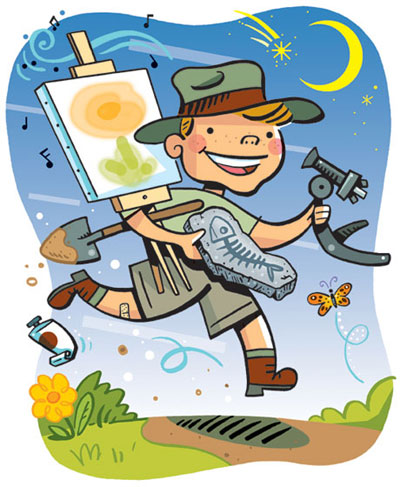
Illustrations: Dave Klug
The words “summer camp” automatically
bring to mind images of water sports, arts and crafts,
and kids singing campfire songs. In the last several
years, Carnegie Museums of Pittsburgh has redefined
summer camp by introducing a wide variety of programs
specifically for kids who want to spend the summer
learning to be scientists, artists, and archaeologists.
The
simple idea of creating practical, educational,
and fun camps has proven to be a winner in several
ways: parents get a worry-free answer to the age-old
question: “How do I keep the kids inspired
during summer vacation?” and kids get to
enjoy exploring their interests with like-minded
peers
and skilled
and knowledgeable teachers. In addition, Carnegie
Museum of Art, Carnegie Museum of Natural History,
and Carnegie
Science Center each get an opportunity to excite
children and their families about their facilities.
Every
year, each camp attracts numerous participants
from the Pittsburgh area and beyond—demonstrating
how both children and parents thirst for this
type of camp experience. “We have a woman
from Ohio who brings her two kids every year
because,
as she
says, ‘There is nothing where I live that
offers this kind of experience,’” says
Nancy Sampson, who schedules classes and camps
at Carnegie Museum
of Natural History.
Carnegie Museums strives to
keep camps fun, educational, and convenient.
Lesson plans eschew school curriculum
in favor of play, creativity, and exploration.
Professional instructors (many of whom are
certified teachers) lead
camps, along with college student assistants
and teen volunteers, with a ratio of about
one supervisor
to
every four campers, so children receive the
attention they need. Pre- and post-camps allow parents
to drop off children as early as 7:30 a.m.
and
pick
them up
as late as 5 or 6 p.m.
“Children get a limited time in school art classes,” says
Nikki Faychak Kalcevic, Carnegie Museum of
Art’s
children’s education programs specialist. “By
the time the teacher explains the project,
the children get maybe 20 minutes to work on
their artwork before
they have to start cleaning up. Our camps are
concentrated. Here, kids get to spend an entire
morning or afternoon
making art.”
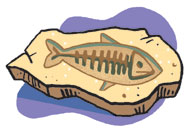 Discovering
the World at Camp Earth Discovering
the World at Camp Earth
In
a large room behind the Museum of Natural History’s
Alcoa Hall of American Indians, a group of six- and
seven-year-olds enthusiastically play a game titled “Kids
Just Wanna Have Fun.” Colorful, camper-created
Native American dream catchers—made from paper
plates, yarn, colored markers, and feathers—are
proudly displayed on a nearby table.
Carnegie Museum
of Natural History’s Camp Earth
summer programs provide children a chance to paint
with celery, soar with bats, and dig for dinosaurs.
The camps—32 were offered over a nine-week
period in 2003—drew 640 campers last year.
Since 2000, more than 3,000 campers have attended.
While some children attend all nine weeks, the
average child registers for two camps every summer. “Kids
go home on Friday and can’t wait to come
back again on Monday,” says Sampson.
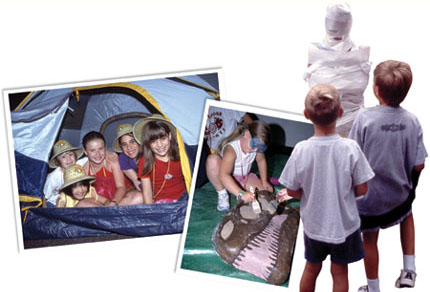
That’s
because Camp Earth is the perfect summer adventure
for aspiring environmentalists, entomologists,
Egyptologists, and anthropologists. Nature lovers
can enroll in “Romp in the Swamp" to
dive deep into the world of the muck and mud;
dinosaur enthusiasts gravitate toward “Dinosaur
Detectives;” Summer
Olympics fans can have a medal ceremony of their
own in "Animalympics," while “Superhero
Science” gives CMU professors and preteens
the rare opportunity to figure out if Spiderman
can really climb a
wall.
Every camp relates to a museum exhibit and,
if possible, to something currently hot with
kids. “Forensic
Files” focuses on a mystery involving a
missing insect and combines investigative techniques
such
as fingerprinting and DNA, visits to the entomology
department, and the popular TV show CSI: Crime
Scene Investigators. A few summers ago, “Survival
Camp” found kids combing the Wyckoff Hall
of Arctic Life for items needed to survive in
a polar
environment a la TV’s Survivor. And what’s
hotter than Harry Potter? Not much, according
to the number of campers already enrolled in “It's
a Wizard's World.”
“
When we started “Camp Dragontooth” a
lot of people said: ‘What does Harry Potter
have to do with the Museum of Natural History?’” Sampson
says. “But we cover owl pellets, potions (herbology),
snakes, and mythical beasts.” Sampson pauses,
smiles, and adds, “We have the dinosaurs stand
in for the dragons.”
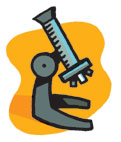
Creating Future Scientists
Children who prefer Carl Sagan to Louis Leakey might
find Carnegie Science Center’s camps—covering
everything from astronomy to engineering—to
their liking.
On the Science Center’s third
floor, the Robotics classroom is littered with tiny
wheels, cogs, and
gears while busy campers attempt to create their
very own Dante II—the CMU robot that explores
live volcanoes. In 2003, Science Center camps welcomed
1,200-plus campers for its weeklong camps. Off-site
camps are offered at Edinboro University and Upper
St. Clair High School.
“
In the last two years the camps have doubled
in size,” says
Education Coordinator Amy Cribbs. “Some
campers sign up for multiple camps, and they’re
here all summer. We have some children that come
from
New York, California, Texas, and even Japan.”
The
27 camps offered over nine weeks in 2003 covered
a range of science topics. “River Camp” teamed
campers with Pittsburgh Voyager (an educational
organization operating river learning classrooms
on two retired
U.S. Navy vessels) to examine Pittsburgh’s
three rivers and learn about river ecology.
Children in “Design Challenge” studied
scale at the Miniature Railroad & Village,
created architectural designs in the computer
lab, and
built model cities.
And “Junior Scientists” explored
a different science daily—from chemistry
and physics to geology and meteorology.

Photos: Tom Altany
As
with the Museum of Natural History, linking
exhibits to camps is a priority. Exhibits are
the main focus
of “Science of OMNIMAX®,” (including
Rangos Omnimax Theater tours and a different
movie daily), while “Railroad Engineers” concentrates
on the Miniature Railroad & Village.
The heart of 2003’s “Science Survivors” was
the Buhl Planetarium and OMNIMAX® Theater’s
Lewis & Clark shows. Field trips come into
play at UPMC SportsWorks’ “Sports
Science” with tours of the UPMC Sports
Medicine Complex, Heinz Field, and PNC Park,
while “Kennywood
Science” features the science behind
amusement park rides and is topped off with
a trip to Kennywood
Park.
Like the Natural History Museum, the
Science Center isn’t above using a pop-culture
phenomenon to attract campers. And so Harry
Potter rears his
bespectacled head again. In “Wizard Camp” kids
learn the science behind shrinky dinks (a moldable
plastic that shrinks when baked), create chocolate
frogs (think Tootsie Rolls, not amphibians),
and how to turn Q-Tips into crystal forests.
“If something is a huge hit and kids love
it, then we try to create a camp around it,” says
Cribbs. “If
they are interested in a topic and we show
them the science behind it, then we can pique
their interest
in science and science careers.”
The Science
Center also sponsors the Mission Discovery
Summer Program—a joint effort between
Carnegie Science Center and The Hill House
Association. Funded
in part by the National Science Foundation,
Mission Discovery promotes science, math, and
technology
education for Hill District middle-school students.
This past summer, 33 students participated
in guided Hill District nature walks and a
Science Center visit
that included a Moon Phases workshop with Planetarium
Director John Radzilowicz. The highlight of
the program, however, was a three-day camping
trip to Powdermill
Nature Reserve—the field station of Carnegie
Museum of Natural History—where students
learned to identify trees, plants, animals,
rocks, insects,
birds, and stars.
“
The opportunity to take students who live in the
city out of their element to experience the surroundings
of the region is an amazing thing to witness,” says
Aleina Smith, director of Community Affairs
for the Science Center.
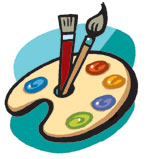
Focus on Art
In the light-filled Children’s Art Studio
at Carnegie Museum of Art, a 6-year-old “Make
Mine Musical” camper fashions a French horn
from brightly colored tape and hardware supplies
as the teacher demonstrates an instrument made
from PVC pipe. Behind the instructor, rows of tin-pie-plate
gongs and maracas—made from film canisters,
dried beans, and painted popsicle sticks—wait
to be played
The Museum of Art’s seven-week
program of weeklong camps (45 in 2003) for those
interested
in drawing, sculpture, painting, photography,
and printmaking attracts nearly 700 children every
summer. Almost half register for more than one
camp each summer. “We have kids who are
here every week because they want to come back,” says
Kalcevic.
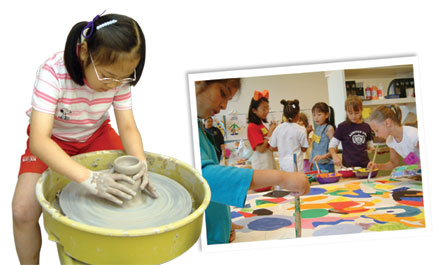
Like the Science Center and Museum of
Natural History, kids play, learn, create,
and visit
exhibitions
at Museum of Art camps. “Parents expect
structured, yet imaginative classes,” she
says. Kalcevic designs camps that “promote
visual thinking strategies, open-ended conversations,
and creative
art-making.”
In camps for all ages, the individual self-expression
of children is the end goal.
In “Exploring Animation,” for instance,
children create flip books based on a character
they have invented.
And, as with the other museums’ camps, the
Museum of Art’s collections and exhibitions
are invaluable. “We’re always linking
the artwork and art projects,” Kalcevic says. “I
work with instructors to review and integrate
their lesson plans with works of art that
will inspire
children.”
“
Ceramics” and “Sculpture” campers
study pieces both inside and outside the
museum, and campers enrolled in drawing,
painting, and
printmaking camps take to the gallery floors
with sketch pads in hand. Last summer, “Photography:
Words and Images,” a camp combining
photography with creative writing, used the
exhibition Documenting
Our Past: The Teenie Harris Archive Project
to teach photographic composition. And Panopticon:
An Art Spectacular exhibition was used for
drawing,
painting, and creating “Playful Puppets” (children
made hand puppets and marionettes based on
the artwork).
Museum of Art camps also capitalize
on local resources. Photography campers visit
Carnegie
Mellon University’s
darkrooms and canvass Oakland for subjects. “Drawn
to Architecture” students stop by Carnegie
Mellon’s Intelligent Work Place; and
budding artists spend time at Phipps Conservatory
and Botanical
Gardens for Monet-style inspiration.
At camps’ end,
student-created pieces are displayed in a
corridor by the Museum of Art’s
Sculpture Court entrance. While some artists
wait a lifetime to see their work displayed
in a world-class
museum, many Museum of Art campers can say
they had their work exhibited before they
graduated
high school.
Seeing your work displayed in
a museum, building a robot to take home,
or sleeping beneath
a beautiful dream catcher you created yourself
is just the
icing on the cake for Carnegie Museums of
Pittsburgh
campers. Any camper will tell you, the real
joy of Carnegie Museums’ camps is spending
the summer doing the things they love.
Back to Contents |